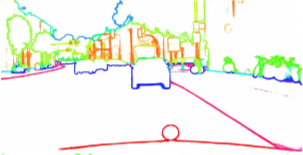This is an implementation for paper CASENet: Deep Category-Aware Semantic Edge Detection.
This repository has been adapted to work with the Cityscapes Dataset.
The author's preprocessing repository was used. Instructions for use can be found in the cityscapes-preprocess directory. This is used to generate binary files for each label in the dataset.
For data loading into hdf5 file, an hdf5 file containing these binary files needs to be generated. For this conversion, run:
python utils/convert_bin_to_hdf5.py
after updating the directory paths (use absolute paths).
The model used is the ResNet-101 variant of CASENet.
The model configuration (.prototxt) can be found: here.
The download links for pretrained weights for CASENet can be found: here.
To use the pretrained caffemodel in PyTorch, use extract-caffe-params to save each layer's weights in numpy format. The code along with instructions for usage can be found in the utils folder.
To load these numpy weights for each layer into a PyTorch model, run:
python modules/CASENet.py
after updating the directory path at this line to the parent directory containing the numpy files (use absolute paths).
NOTE: The Pytorch pre-trained weights can be downloaded from: Google Drive.
For training, run:
python main.py
Optional arguments:
-h, --help show help message and exit
--checkpoint-folder path to checkpoint dir (default: ./checkpoint)
--multigpu use multiple GPUs (default: False)
-j, --workers number of data loading workers (default: 16)
--epochs number of total epochs to run (default: 150)
--start-epoch manual epoch number (useful on restarts)
--cls-num The number of classes (default: 19 for Cityscapes)
--lr-steps iterations to decay learning rate by 10
--acc-steps steps for Gradient accumulation (default: 1)
-b, --batch-size mini-batch size (default: 1)
--lr lr (default: 1e-7)
--momentum momentum (default: 0.9)
--weight-decay weight decay (default: 1e-4)
-p, --print-freq print frequency (default: 10)
--resume-model path to latest checkpoint (default: None)
--pretrained-model path to pretrained checkpoint (default: None)
For visualizing feature maps, ground truths and predictions, run:
python visualize_multilabel.py [--model MODEL] [--image_file IMAGE] [--image_dir IMAGE_DIR] [--output_dir OUTPUT_DIR]
For example, to visualize on the validation set of Cityscapes dataset:
python visualize_multilabel.py -m pretrained_models/model_casenet.pth.tar -f leftImg8bit/val/lindau/lindau_000045_000019_leftImg8bit.png -d cityscapes-preprocess/data_proc/ -o output/
For testing a pretrained model on new images, run:
python get_results_for_benchmark.py [--model MODEL] [--image_file IMAGE] [--image_dir IMAGE_DIR] [--output_dir OUTPUT_DIR]
For example,
python get_results_for_benchmark.py -m pretrained_models/model_casenet.pth.tar -f img1.png -d images/ -o output/
A class wise prediction map will be generated in the output directory specified.
- Added script to convert edges to contours and visualize
- Implemented gradient accumulation to increase batch size without increasing memory usage.
- Cleared unused variable to empty cache memory.
-
Data processing was done from the following repository: https://github.com/Chrisding/cityscapes-preprocess
-
Conversion from caffemodel to numpy format was done using the following repository: https://github.com/nilboy/extract-caffe-params
-
The model was heavily referenced from the following repository for the Semantic Boundaries Dataset: https://github.com/lijiaman/CASENet
-
The original Caffe implementation of the paper, can be downloaded from the following link: http://www.merl.com/research/license#CASENet



